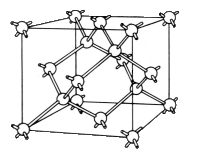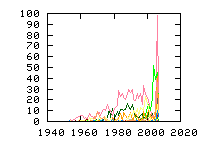« Previous
1
Next »
(9 hits, 1/1)
Showing
10, 25, 50, 100, 500, 1000, all papers per page.
Sort by:
last publication date,
older publication date,
last update date.
- 1. Appl. Phys. Lett. 81, 2397-2399 (2002) , “Hydrogen redistribution induced by negative-bias-temperature stress in metal–oxide–silicon diodes”, Ziyuan LiuPoly-Si/SiO2/Si diodes in which oxides were grown thermally under wet oxidation conditions and subsequently treated by a post-oxidation anneal (POA) have been characterized electrically and chemically before and after applying negative-bias-temperature stress (NBTS). It was confirmed that... (Read more)
- 2. Jpn. J. Appl. Phys. 24, 279 (1985) , “Solubility and Diffusion Coefficient of Oxygen in Silicon ”, Yoshiko Itoh and Tadashi NozakiThe solubility and diffusion coefficient of oxygen in silicon between 1000°C and 1375°C were examined by charged particle activation analysis with the 16O(3He, p)18F reaction, in which oxygen was activated with an equal probability over the depth of up to 250... (Read more)
- 3. Appl. Phys. A 30, 1 (1983) , “Transition Metals in Silicon”, E. R. Weber.A review is given on the diffusion, solubility and electrical activity of 3d transition metals in silicon. Transition elements (especially, Cr, Mn, Fe, Co, Ni, and Cu) diffuse interstitially and stay in the interstitial site in thermal equilibrium at the diffusion temperature. The parameters of the liquidus curves are identical for the Si:Ti — Si:Ni melts, indicating comparable silicon-metal interaction for all these elements. Only Cr, Mn, and Fe could be identified in undisturbed interstitial sites after quenching, the others precipitated or formed complexes. The 3d elements can be divided into two groups according to the respective enthalpy of formation of the solid solution. The distinction can arise from different charge states of these impurities at the diffusion temperature. For the interstitial 3d atoms remaining after quenching, reliable energy levels are established from the literature and compared with recent calculations. (Read more)
- 4. phys. stat. sol. (b) 210, 415-427 (1998) , “The Microscopic and Electronic Structure of Shallow Donors in SiC”, S. Greulich-WeberNitrogen donors in 6H-, 4H- and 3C-SiC were investigated using conventional electron paramagnetic resonance (EPR) and electron nuclear double resonance (ENDOR) and the experimental results are discussed. An attempt is presented to interpret the experimentally found large differences in hyperfine... (Read more)
- 5. Phys. Rev. Lett. 98, 252501 (2007) , “Radioactive Decay Speedup at T=5 K: Electron-Capture Decay Rate of 7Be Encapsulated in C60”, T. Ohtsuki, K. Ohno, T. Morisato, T. Mitsugashira, K. Hirose, H. Yuki, and J. KasagiThe electron-capture (EC) decay rate of 7Be in C60 at the temperature of liquid helium (T=5 K) was measured and compared with the rate in Be metal at T=293 K. We found that the half-life of 7Be in endohedral C60... (Read more)
- 6. J. Appl. Phys. 35, 379-397 (1964) , “Diffusion and Solubility of Copper in Extrinsic and Intrinsic Germanium, Silicon, and Gallium Arsenide”, R. N. Hall and J. H. RacetteThe solubilities of substitutional and interstitial copper (Cus and Cui) have been measured in intrinsic and extrinsic n- and p-type Ge, Si, and GaAs, using Cu64. These measurements show that Cus is a triple acceptor in... (Read more)
- 7. Phys. Rev. B 62, 12888-12895 (2000) , “Tungsten in silicon carbide:?Band-gap states and their polytype dependence”, N. Achtziger, G. Pasold, R. Sielemann, C. H?lsen, J. Grillenberger, and W. WitthuhnBand-gap states of tungsten in silicon carbide (polytypes 4H, 6H, and 15R) are investigated by deep-level transient spectroscopy (DLTS) and admittance spectroscopy on n-type SiC. Doping with W is done by ion implantation and annealing. To establish a definite chemical identification of band-gap... (Read more)
- 8. Phys. Rev. B 47, 10899-10902 (1993) , “Defects in porous p-type Si: An electron-paramagnetic-resonance study”, H. J. von Bardeleben, D. Stievenard, A. Grosman, C. Ortega, J. SiejkaThe defects in p+ porous silicon of low and high porosity have been studied by using electron-paramagnetic-resonance (EPR) spectroscopy and compared with an impurity analysis obtained from nuclear reaction analysis (NRA). The EPR measurements show, in both high- and low-porosity samples,... (Read more)
- 9. Phys. Rev. Lett. 89, 256102 (2002) , “Limiting Step Involved in the Thermal Growth of Silicon Oxide Films on Silicon Carbide”, I. C. Vickridge, I. Trimaille, J.-J. Ganem, S. Rigo, C. Radtke, I. J. R. Baumvol, F. C. StedileThermal growth of silicon oxide films on silicon carbide in O2 was investigated using oxygen isotopic substitution and narrow resonance nuclear reaction profiling. This investigation was carried out in parallel with the thermal growth of silicon oxide films on Si. Results demonstrate that... (Read more)
« Previous
1
Next »
(9 hits, 1/1)
Showing
10, 25, 50, 100, 500, 1000, all papers per page.
Sort by:
last publication date,
older publication date,
last update date.
All papers (3399)
Updated at 2010-07-20 16:50:39
Updated at 2010-07-20 16:50:39
(view as: tree
,
cloud
)
| 1329 | untagged |
Materials
(111 tags)
Others(101 tags)
Technique
(46 tags)
Details
(591 tags)
Bond(35 tags)
Defect(interstitial)(18 tags)
Defect(vacancy)(15 tags)
Defect-type(19 tags)
Element(65 tags)
Energy(8 tags)
Isotope(56 tags)
Label(303 tags)
Sample(17 tags)
Spin(8 tags)
Symmetry(15 tags)

